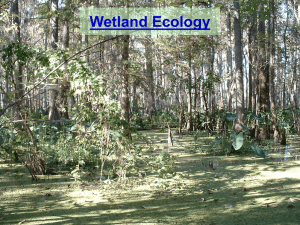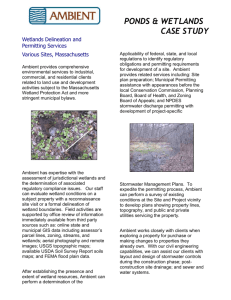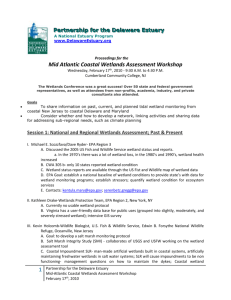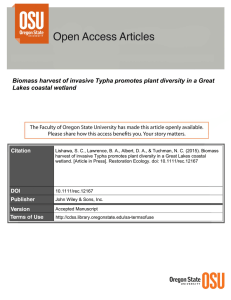Measuring Avian and Herptile Response to Wetland Enhancement
advertisement
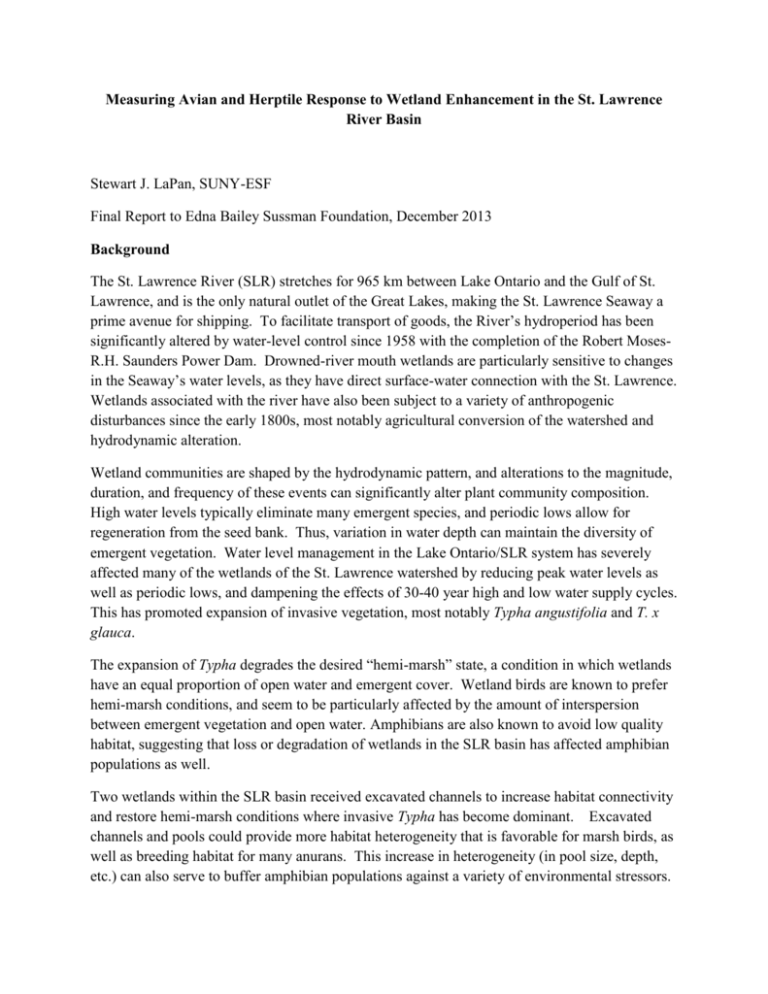
Measuring Avian and Herptile Response to Wetland Enhancement in the St. Lawrence River Basin Stewart J. LaPan, SUNY-ESF Final Report to Edna Bailey Sussman Foundation, December 2013 Background The St. Lawrence River (SLR) stretches for 965 km between Lake Ontario and the Gulf of St. Lawrence, and is the only natural outlet of the Great Lakes, making the St. Lawrence Seaway a prime avenue for shipping. To facilitate transport of goods, the River’s hydroperiod has been significantly altered by water-level control since 1958 with the completion of the Robert MosesR.H. Saunders Power Dam. Drowned-river mouth wetlands are particularly sensitive to changes in the Seaway’s water levels, as they have direct surface-water connection with the St. Lawrence. Wetlands associated with the river have also been subject to a variety of anthropogenic disturbances since the early 1800s, most notably agricultural conversion of the watershed and hydrodynamic alteration. Wetland communities are shaped by the hydrodynamic pattern, and alterations to the magnitude, duration, and frequency of these events can significantly alter plant community composition. High water levels typically eliminate many emergent species, and periodic lows allow for regeneration from the seed bank. Thus, variation in water depth can maintain the diversity of emergent vegetation. Water level management in the Lake Ontario/SLR system has severely affected many of the wetlands of the St. Lawrence watershed by reducing peak water levels as well as periodic lows, and dampening the effects of 30-40 year high and low water supply cycles. This has promoted expansion of invasive vegetation, most notably Typha angustifolia and T. x glauca. The expansion of Typha degrades the desired “hemi-marsh” state, a condition in which wetlands have an equal proportion of open water and emergent cover. Wetland birds are known to prefer hemi-marsh conditions, and seem to be particularly affected by the amount of interspersion between emergent vegetation and open water. Amphibians are also known to avoid low quality habitat, suggesting that loss or degradation of wetlands in the SLR basin has affected amphibian populations as well. Two wetlands within the SLR basin received excavated channels to increase habitat connectivity and restore hemi-marsh conditions where invasive Typha has become dominant. Excavated channels and pools could provide more habitat heterogeneity that is favorable for marsh birds, as well as breeding habitat for many anurans. This increase in heterogeneity (in pool size, depth, etc.) can also serve to buffer amphibian populations against a variety of environmental stressors. The increased connectivity is also expected to benefit turtle populations in these wetlands by promoting conditions favorable to their preferred food sources, such as pondweeds and small fish. In addition, water level control structures have been installed in three wetlands to maintain higher, more natural water levels. These higher levels also provide more stability for amphibian breeding habitats, and many secretive marsh birds have been shown to prefer deeper waters. Higher water levels may also sustain more dissolved oxygen, indirectly benefiting piscivorous turtles and birds by fostering more stable prey fish populations. The primary objective of this study is to understand how channel/spawning pool excavations and water level control structures impact avian and herptile populations in wetlands of the SLR system. To do this, treated wetlands were surveyed along with untreated wetland control sites. I intend to use a combination of general linear models and principal coordinate analysis to detect correlations between the two treatment types and marsh bird, turtle, and amphibian density and species richness. Work Completed During the summer of 2012, I selected three treated wetlands and three control sites to survey. I monitored marsh birds in each using a combination of passive point counts and breeding call broadcasts for secretive indicator species. Indicator species included: least bittern (Ixobrychus exilis), sora (Porzana carolina), Virginia rail (Rallus limicola), king rail (Rallus elegans), and American bittern (Botaurus lentiginosus) I used automated SM2 Songmeters (Wildlife Acoustics) to survey amphibians, placing them at 200 m intervals throughout each wetland which recorded continuously throughout the evening during peak calling hours. Turtles were captured,identified to species, marked, measured and released using baited 3’ hoop nets from June to August. During the summer of 2013, using Sussman funding, two more treated wetlands and two control sites were added to the project. These sites served as water level control replicates. I surveyed each treated site and its associated control wetland concurrently for all taxa. In addition, the Pied-billed grebe (Podilymbus podiceps) was added to the call broadcast survey for marsh birds. Bird surveys were conducted from May 15 to June 15, 2013. I sampled turtle populations once again, trapping from June 1 to August 10, for a total of three weeks of trapping at each study site. I recorded amphibian breeding calls using SM2 song meters in all sites from April 15 to July 30, and collected over 140 hours of audio data across the two field seasons. I also used the Sussman funding to conduct surveys of submerged-aquatic and emergent vegetation for comparison between sites. Preliminary Results P. limicola, an indicator marsh bird species, was detected exclusively at one site, a water level controlled wetland. In addition, the marsh wren (Cistothorus palustris) was found only in water level controlled sites. Raw bird species richness for all sites is presented in Figure 1. Preliminary results show that indicator species richness was lowest at an excavation site, and highest at a water level control site. Overall species richness was highest at an excavation site, and lowest at an untreated reference site. Blanding’s turtle (Emydoidea blandingii), a threatened species in NY, was present in three water level control sites and their associated reference wetlands, but not in any excavated study areas. Future Work All data have been collected for this project. In Spring 2014, I will analyze the collected data using general linear models and principal coordinate analysis. A full report and thesis will be generated by May 2014. Acknowledgements I would like to thank my advisers, Dr. James Gibbs and Dr. John Farrell, for all of their guidance and input. I would also like to thank the staff of the Thousand Islands Biological Station for their assistance throughout the last two field seasons. Thank you to the Edna Bailey Sussman Foundation and council members for your support of this research. The Foundation will be recognized in all presentations and publications that result from this research. Figure 1. Raw bird species richness for each wetland surveyed. Wetlands are arranged into the two treatment categories and the untreated reference sites.






